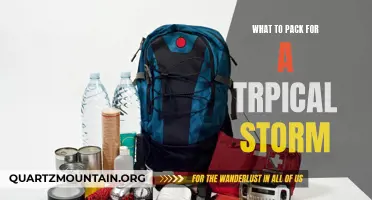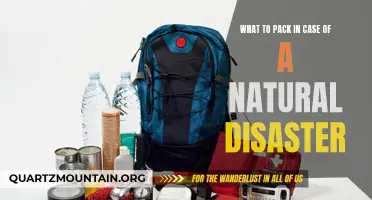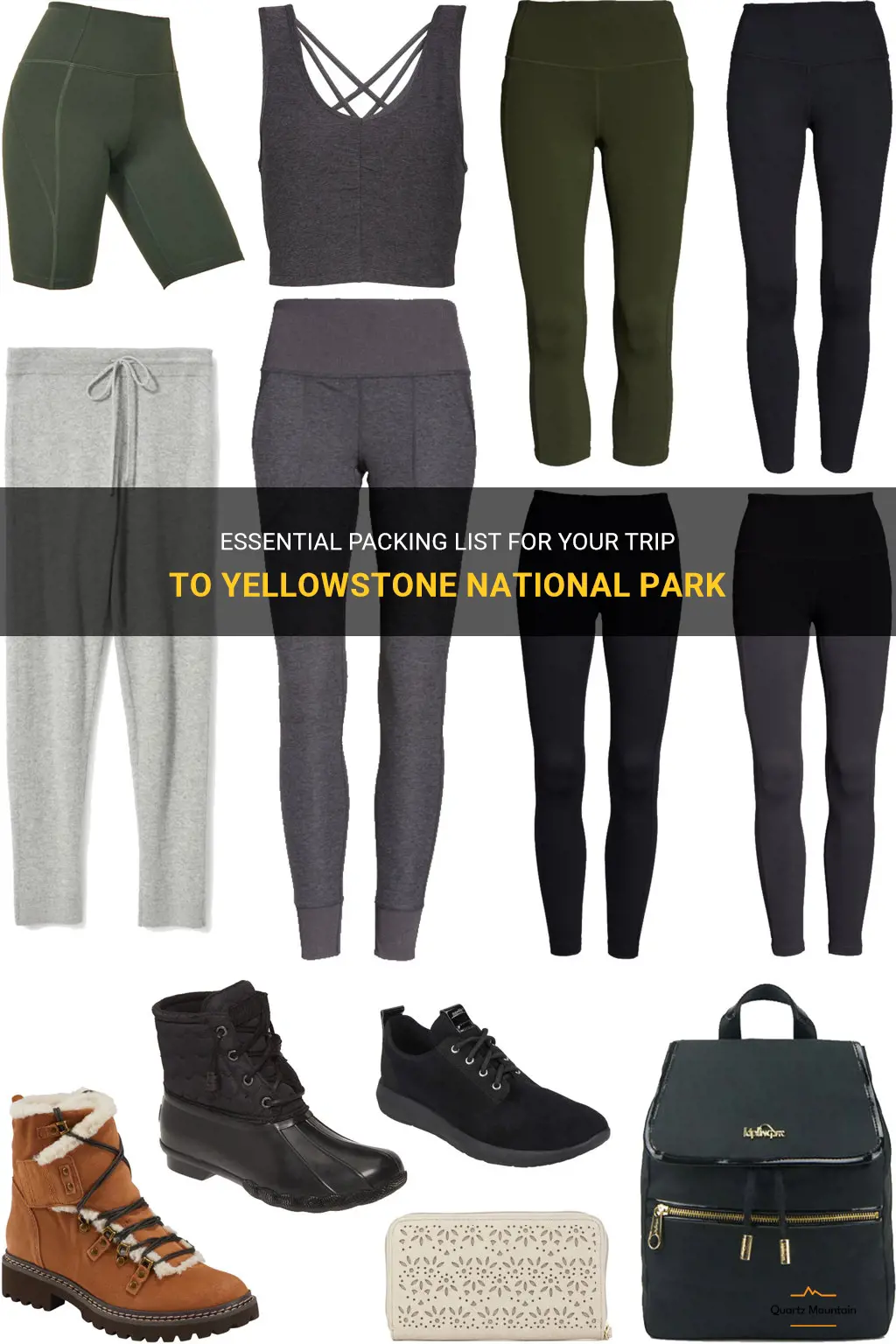
Heading to Yellowstone National Park? Don't forget to pack these essentials! Whether you're a seasoned hiker or a nature enthusiast, this packing list will ensure that you have everything you need for an amazing adventure in one of the most stunning and diverse national parks in the United States. From hiking boots to bear spray, we've got you covered. So grab your backpack and get ready to explore the awe-inspiring wonders of Yellowstone!
What You'll Learn
- What are the essential items to pack for a trip to Yellowstone National Park?
- Are there any specific clothing items or gear that should be included in your packing list for Yellowstone?
- What kind of footwear is recommended for exploring the park and its trails?
- Are there any important documents or permits that should be packed for a trip to Yellowstone?
- Is there anything unique to Yellowstone that should be included in your packing list, such as bear spray or specific camping gear?

What are the essential items to pack for a trip to Yellowstone National Park?

Yellowstone National Park is a stunning and diverse destination for outdoor enthusiasts. Located primarily in Wyoming, with parts in Montana and Idaho, this magnificent park covers over 2 million acres and is known for its geothermal features, abundant wildlife, and breathtaking scenery. If you're planning a trip to Yellowstone, it's important to pack the essential items to ensure a comfortable and enjoyable experience. Here are some key items to include in your packing list:
- Clothing for All Weather Conditions: Yellowstone's weather can be unpredictable, with temperatures ranging from hot summers to freezing winters. It's important to pack layers of clothing that can be easily added or removed as the weather changes. Be sure to include items such as a waterproof jacket, thermal base layers, a hat, gloves, and sturdy hiking boots.
- Insect Repellent: Yellowstone is home to various insects, including mosquitoes and ticks. To protect yourself from bites and potential diseases, pack an effective insect repellent. Look for one that contains DEET and apply it before heading outdoors.
- Sun Protection: The sun's rays can be intense at high altitudes, so it's crucial to pack sun protection items. This should include a broad-spectrum sunscreen with a high SPF, sunglasses to protect your eyes, and a wide-brimmed hat to shield your face and neck from the sun.
- Hiking Gear: Yellowstone offers endless opportunities for hiking and exploring its vast wilderness. Make sure you have a comfortable backpack to carry essentials like water, snacks, a map, and a compass. Additionally, invest in a sturdy pair of hiking boots that provide ankle support and traction on the park's rugged terrain.
- Bear Safety Supplies: Yellowstone is home to grizzly bears and black bears, so it's important to be prepared for encounters with these animals. Pack bear spray, a canister containing a potent pepper spray that can deter a bear if needed. Familiarize yourself with how to use it properly before your trip.
- Binoculars and Camera: Yellowstone is famous for its abundant wildlife, from bears and wolves to buffalo and elk. To get the most out of your wildlife viewing experiences, pack a pair of binoculars to spot animals from a distance. Don't forget to bring a camera or smartphone with a good zoom lens to capture those memorable moments.
- Water and Snacks: Staying hydrated is crucial while exploring Yellowstone, especially at high altitudes. Pack a refillable water bottle and bring plenty of snacks to keep your energy levels up during hikes and excursions.
- Camping Essentials: If you plan on camping in Yellowstone, be sure to pack a spacious tent, warm sleeping bags, and comfortable sleeping pads. Additionally, bring cooking supplies, such as a portable stove, pots, and utensils, as well as food that can be stored safely from wildlife.
- First Aid Kit: Accidents can happen, so it's wise to be prepared with a well-stocked first aid kit. Include items such as band-aids, antiseptic wipes, pain relievers, and any personal medications you may need.
- Maps and Guidebooks: Yellowstone is vast, so it's essential to have a map or guidebook to navigate the park efficiently and learn about its various attractions, trails, and safety regulations.
By packing these essential items, you'll be well-prepared for a trip to Yellowstone National Park. Remember to research and plan ahead for any special permits or reservations you may need, as well as to familiarize yourself with the park's rules and regulations to ensure a safe and enjoyable adventure.
Essential Items for a Memorable Himalayan Motorcycle Trip: What to Pack
You may want to see also

Are there any specific clothing items or gear that should be included in your packing list for Yellowstone?
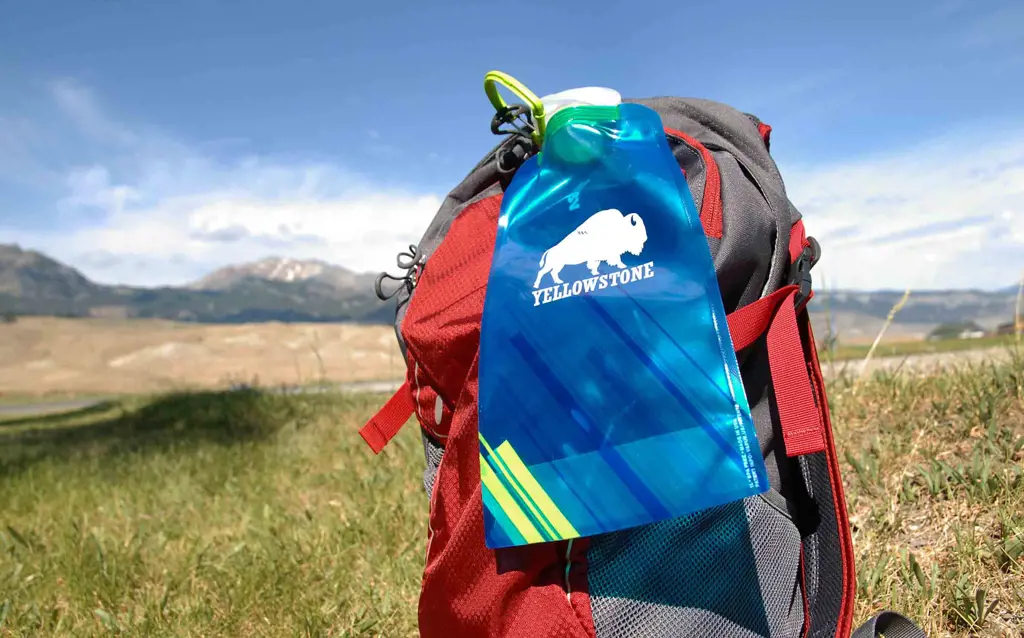
Yellowstone National Park is a vast and diverse wilderness, spanning across three states and covering over 2 million acres. With its abundant wildlife, geysers, and stunning landscapes, Yellowstone is a popular destination for outdoor enthusiasts and nature lovers. However, it is essential to come prepared with the right clothing and gear to fully enjoy your trip and stay safe in the park's unpredictable weather conditions.
Layered Clothing:
Yellowstone's weather can change rapidly, even within the same day. It is crucial to dress in layers to adapt to these fluctuations. Start with a moisture-wicking base layer, such as thermal or synthetic materials, to keep your skin dry and regulate body temperature. Over this, wear insulating layers like fleece or down jackets to trap body heat. Finally, top it off with a waterproof and windproof outer layer, such as a durable rain jacket or a shell. This layering system allows you to add or remove clothing depending on the temperature and conditions.
Hiking Boots:
As Yellowstone offers countless hiking trails, sturdy and comfortable hiking boots are a must. Look for boots with ankle support, a good tread, and waterproof features to protect your feet from wet and rugged terrains. Break them in before your trip to avoid painful blisters.
Hats and Sunglasses:
Sun protection is crucial when exploring Yellowstone. Make sure to pack a wide-brimmed hat or a cap to shield your face from the sun's rays. Sunglasses with UV protection are also essential to protect your eyes from glare and harmful UV rays.
Gloves and Thermal Socks:
In Yellowstone, temperatures can drop significantly, especially during the evenings and at higher elevations. Pack a pair of thermal or wool gloves to keep your hands warm and protect them from wind chill. Thermal socks are also beneficial to keep your feet cozy in colder weather.
Backpack and Water Bottle:
To carry all your essentials during hikes, bring a sturdy backpack with comfortable shoulder straps and adequate storage space. Additionally, bring a reusable water bottle to stay hydrated during your outdoor adventures. Yellowstone's unpolluted water sources make it safe to refill your bottle from rivers and streams.
Insect Repellent and Sunscreen:
The park is home to various insects, including mosquitoes and ticks. Apply a reliable insect repellent to ward off these pests and prevent insect bites. Yellowstone also sits at a higher elevation, resulting in a thinner atmosphere that allows more UV radiation to reach the earth's surface. Protect your skin from sunburn and long-term damage by applying and reapplying sunscreen with a high SPF rating.
Binoculars and Camera:
Yellowstone is famous for its wildlife, including bears, wolves, elk, and bison. Bring a pair of binoculars to observe animals from a safe distance. Additionally, pack a camera with extra batteries and memory cards to capture the breathtaking landscapes and wildlife sightings you encounter.
Remember, always check the weather forecast before your trip and adjust your packing list accordingly. Being prepared with the right clothing and gear will ensure a comfortable and enjoyable experience in Yellowstone National Park.
The Ultimate Guide: What to Pack for a Summer Trip in Europe
You may want to see also

What kind of footwear is recommended for exploring the park and its trails?
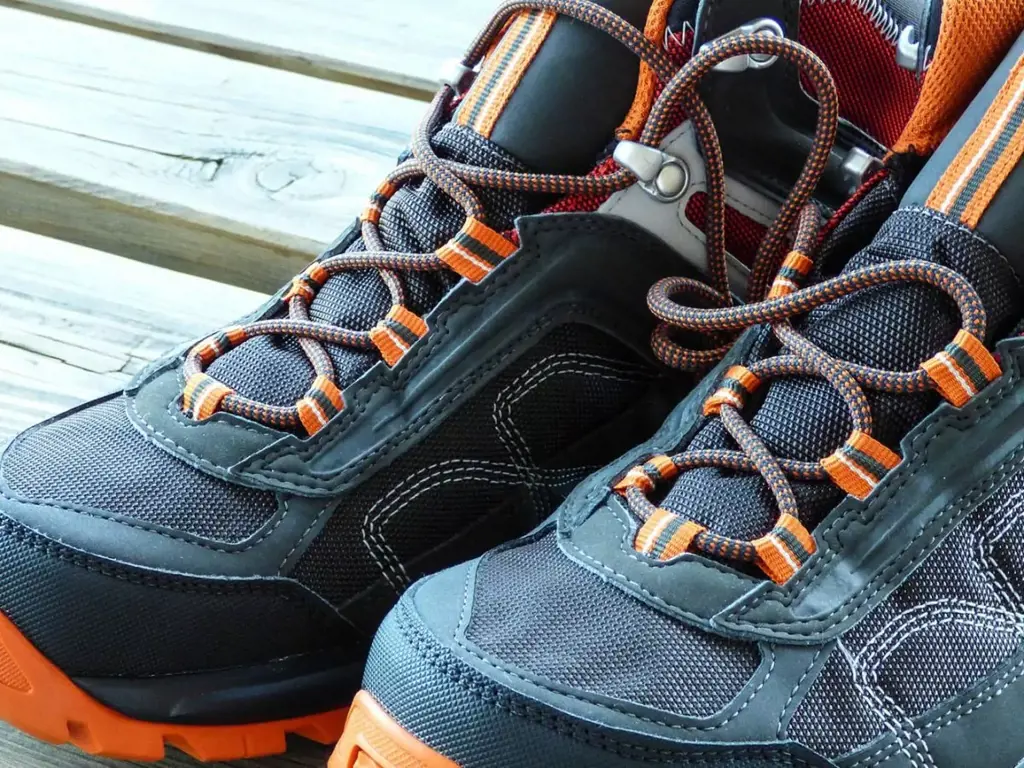
When it comes to exploring a park and its trails, it is crucial to have the right kind of footwear to ensure comfort, safety, and a pleasant experience. The terrain of parks and trails can vary greatly, from well-maintained paths to rugged and uneven surfaces. Therefore, choosing the appropriate footwear is essential for a successful adventure.
One of the most important factors to consider when selecting footwear for park exploration is the level of support and stability they offer. As you will be walking on different types of terrain, including uneven surfaces and potentially slippery areas, it is vital for your footwear to provide adequate support to your feet and ankles. This will help prevent strains, sprains, and other potential injuries.
Another crucial factor to take into account is the traction of the footwear. Many parks and trails can be muddy, slippery, or covered in loose gravel. Having excellent traction on your shoes will ensure that you have a secure grip on the ground, making it less likely for you to slip and fall. Look for shoes with rubber outsoles and deep treads that provide excellent traction on various surfaces.
Furthermore, consider the level of cushioning and shock absorption of the footwear. Walking or hiking in a park often involves spending long periods on your feet, which can put strain on your joints and muscles. Shoes with ample cushioning can help absorb shock and provide a comfortable experience, even on rugged terrain. Look for footwear with cushioned midsoles and supportive insoles to maximize comfort.
In addition to support, traction, and cushioning, it is also worth considering the breathability and water resistance of your footwear. Walking in a park may involve encountering wet grass, small streams, or even rainfall. Having shoes that are water-resistant or quick-drying will help keep your feet dry and comfortable throughout your exploration. Additionally, breathable materials can help prevent sweaty and uncomfortable feet, especially during warm weather.
Now that we have discussed the important features to look for, let's explore some specific examples of footwear that are recommended for park exploration. Trail running shoes are a popular choice due to their lightweight design, excellent traction, and cushioned soles. They are designed for off-road running, making them ideal for park trails. Hiking shoes or boots are another great option, providing more ankle support and durability for rugged terrains.
In summary, when it comes to exploring a park and its trails, it is important to prioritize footwear that offers support, traction, cushioning, breathability, and water resistance. Finding the right footwear will not only enhance your comfort and safety but also allow you to fully enjoy the beauty and serenity of the park. With the right shoes, you can confidently navigate any terrain and make the most of your park exploration adventure.
Essential Items to Pack in Your Tennis Bag: A Comprehensive Guide
You may want to see also

Are there any important documents or permits that should be packed for a trip to Yellowstone?
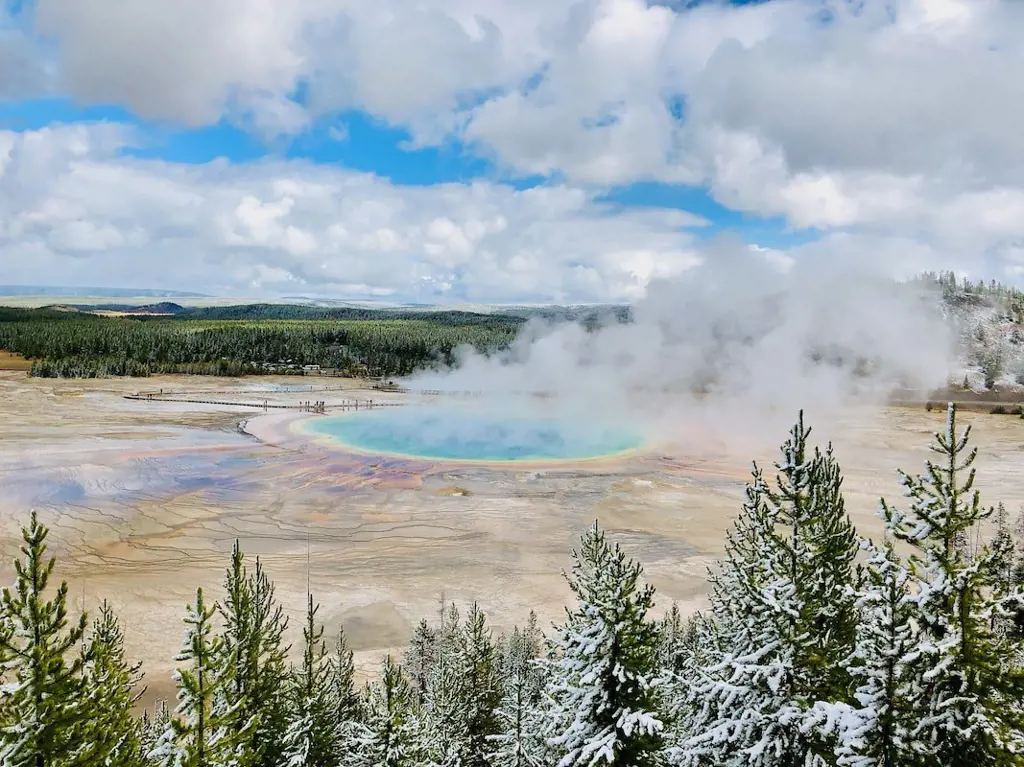
When planning a trip to Yellowstone National Park, there are a few important documents and permits that you should pack to ensure a smooth and hassle-free visit. These documents are essential for entering the park, participating in certain activities, and complying with park regulations. Here are some of the key documents and permits to include in your packing list:
- Identification: It is always important to carry a valid form of identification with you when traveling, and this is no different for a trip to Yellowstone. Make sure to pack your driver's license or passport to prove your identity at park entrance stations, visitor centers, and during any interactions with park rangers.
- Vehicle Registration and License: If you are planning to drive your own vehicle into the park, you should have your vehicle registration and proof of insurance readily available. Some park activities, such as backcountry camping or fishing with a boat, may also require specific permits or licenses. It is best to research these requirements before your trip and have the necessary documents on hand.
- National Park Pass: Yellowstone National Park is part of the National Park System, and if you frequently visit national parks, it may be worth investing in an annual park pass. The America the Beautiful Pass provides access to more than 2,000 federal recreation sites, including Yellowstone. This pass can save you money on entrance fees and is valid for a full year from the month of purchase. If you do not have an annual pass, make sure to bring enough cash or a credit card to pay the park entrance fee.
- Backcountry Permit: If you plan on backpacking or camping in the backcountry, you will need a backcountry permit. These permits are required for overnight stays in the backcountry and can be obtained through the park's reservation system or in-person at visitor centers. It is important to secure a permit in advance to ensure availability and compliance with park regulations.
- Fishing License: Yellowstone National Park offers excellent fishing opportunities, but a state fishing license is required for anyone over the age of 15. The park is located in three different states – Wyoming, Montana, and Idaho – so be sure to familiarize yourself with the specific fishing regulations and licensing requirements of the state you will be fishing in.
- Wildlife Viewing Guidelines: While not a physical document, it is vital to educate yourself on the park's wildlife viewing guidelines. Yellowstone is home to a diverse array of wildlife, including bears, wolves, and bison. Understanding how to safely view and interact with wildlife is essential for your safety, as well as the protection of the animals and their habitat. Familiarize yourself with the park's guidelines and respect any closures or restrictions that may be in place.
In conclusion, when preparing for a trip to Yellowstone National Park, it is essential to pack important documents and permits to ensure a smooth and enjoyable experience. These may include identification, vehicle registration and license, a national park pass, backcountry permits, fishing licenses, and knowledge of wildlife viewing guidelines. By being prepared with these documents, you can focus on enjoying the park's natural wonders and have a memorable trip to Yellowstone.
Essential Items to Pack for a Trip to Gothenburg, Sweden
You may want to see also

Is there anything unique to Yellowstone that should be included in your packing list, such as bear spray or specific camping gear?

When planning a trip to Yellowstone National Park, it's essential to make sure you have all the necessary items for a safe and enjoyable experience. Yellowstone is unique in many ways, including its diverse wildlife and rugged wilderness. There are a few specific items that should be included in your packing list to ensure you are properly prepared for your time in the park.
One item that is highly recommended for anyone visiting Yellowstone is bear spray. Yellowstone is home to grizzly bears and black bears, and encounters with these animals can be dangerous if not handled correctly. Bear spray is a proven deterrent and can help protect you in the event of a bear encounter. It is essential to have the spray easily accessible, preferably in a holster or belt clip. It's also crucial to familiarize yourself with how to use it correctly before venturing into the park.
Additionally, proper camping gear is essential when staying overnight in Yellowstone. Whether you're planning to stay in a developed campground or backcountry camp, having the right equipment is crucial for a comfortable and safe experience. A sturdy tent, warm sleeping bag, and a reliable camping stove are must-have items. The weather in Yellowstone can be unpredictable, so it's crucial to have gear that can handle potential rain, wind, or even snow.
When packing for Yellowstone, it's also important to consider the park's geothermal areas. Yellowstone is known for its hot springs, geysers, and thermal features. If you plan to visit these areas, it's important to bring appropriate footwear. Comfortable walking shoes with good traction are essential, as many of the boardwalks and trails in these areas can be slippery. It's also recommended to pack a hat and sunscreen, as the sun can be intense at high elevations.
Another unique aspect of Yellowstone is its extensive network of hiking trails. If you plan to explore the park on foot, it's crucial to bring the necessary gear. A good pair of hiking boots is essential, as the trails can be rough and uneven. It's also a good idea to bring a daypack with essentials such as water, snacks, a map, and a compass. Additionally, it's important to dress in layers, as the weather in the park can change throughout the day.
Lastly, don't forget your camera! Yellowstone offers breathtaking views and incredible wildlife sightings. Whether you have a professional DSLR or just a smartphone, be sure to bring a way to capture the memories and document your adventures.
In conclusion, Yellowstone National Park is a unique and captivating destination with many natural wonders to explore. When preparing for your trip, be sure to include bear spray, proper camping gear, appropriate footwear for geothermal areas, hiking gear, and a camera. By packing these essential items, you will be well-prepared for your time in Yellowstone and ensure a safe and enjoyable experience.
Essential Gear Checklist for an Unforgettable Climbing Trip
You may want to see also
Frequently asked questions
When packing for a trip to Yellowstone, it's important to remember to bring layers of clothing, as the weather can change quickly. Be sure to pack a warm jacket, hat, gloves, and a raincoat. Comfortable hiking shoes or boots are also essential, as there are many trails to explore. Don't forget to bring sunscreen, sunglasses, and a hat to protect yourself from the sun. It's also a good idea to pack a reusable water bottle and snacks for the day.
If you're planning on wildlife viewing in Yellowstone, it's a good idea to bring binoculars or a camera with a telephoto lens to get a closer look at the animals. It's also important to pack bear spray as a precautionary measure in case you encounter a bear. Additionally, a guidebook or field guide on Yellowstone's wildlife can be helpful in identifying the different species you may come across.
In addition to clothing and gear specific to the activities you plan on doing, there are a few other essentials to pack for a trip to Yellowstone. These include a backpack to carry your water, snacks, and other day-trip essentials, a map or GPS device to help navigate the park, a flashlight or headlamp for any nighttime activities, and a first aid kit for any minor injuries or emergencies. It's also a good idea to pack insect repellent to protect against mosquitoes and other biting insects.




